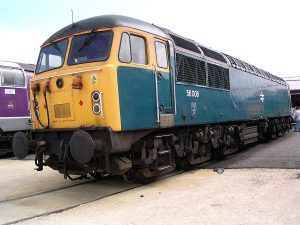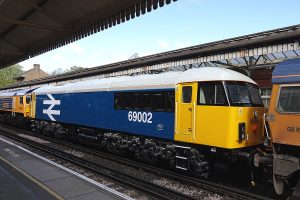Introduction:
In the dynamic world of railway transportation, the British Rail Class 69 locomotive has emerged as a symbol of innovation and adaptability. Originally built as Class 56 diesel locomotives, these trains underwent a remarkable transformation to become the Class 69, showcasing the resilience of railway engineering. In this article, we delve into the fascinating history, design, and impact of the Class 69 locomotives on the British rail network.
Historical Evolution:

The story of the Class 69 begins with the Class 56, a workhorse of the British Railways introduced in the late 1970s. These diesel locomotives were reliable and powerful, serving various freight and passenger routes across the United Kingdom. However, as technology advanced and environmental concerns grew, the need for an upgrade became apparent.
In the early 21st century, a decision was made to repurpose the Class 56 locomotives, breathing new life into these stalwarts rather than retiring them. The ambitious project aimed to address environmental issues, improve efficiency, and extend the operational life of the locomotives.
Technical Transformation:
The transformation of the Class 56 into the Class 69 involved a comprehensive technical overhaul. The outdated power units were replaced with modern, environmentally friendly engines. This not only reduced emissions but also increased fuel efficiency, aligning with the contemporary focus on sustainability in railway operations.
Moreover, the traction control systems were upgraded, enhancing the locomotives’ overall performance. The Class 69 became a testament to the blending of heritage with modern engineering, combining the robust design of the Class 56 with cutting-edge technology.
Operational Significance:

The introduction of Class 69 locomotives brought about a significant shift in the dynamics of railway operations. These versatile locomotives found application in various freight and passenger services, proving their adaptability to different terrains and operational requirements. The revamped power and control systems allowed for smoother acceleration and deceleration, contributing to a more efficient and reliable rail service.
The Class 69 locomotives also played a crucial role in meeting the evolving demands of the freight industry. With increased hauling capacity and improved performance, they became integral to the transportation of goods across the country, demonstrating the enduring importance of diesel locomotives in the modern rail network.
Challenges and Solutions:
Despite their success, the Class 69 locomotives faced challenges inherent in repurposing aging rail assets. Maintenance and spare parts availability were concerns that had to be carefully addressed to ensure the continued reliability of these revamped locomotives. The railway industry’s response to these challenges showcased its commitment to sustainability and the efficient use of resources.
Conclusion:
The British Rail Class 69 locomotive stands as a testament to the resilience and adaptability of railway engineering. The successful transformation of the Class 56 into the Class 69 not only extended the operational life of these locomotives but also demonstrated the industry’s commitment to sustainability and efficiency.
As the railway sector continues to evolve, the story of the Class 69 serves as an inspiring example of how heritage and modernity can coexist on the tracks. These locomotives, once the backbone of the British Railways, have found a new lease on life, contributing to the efficient and sustainable movement of people and goods across the United Kingdom’s extensive rail network.






